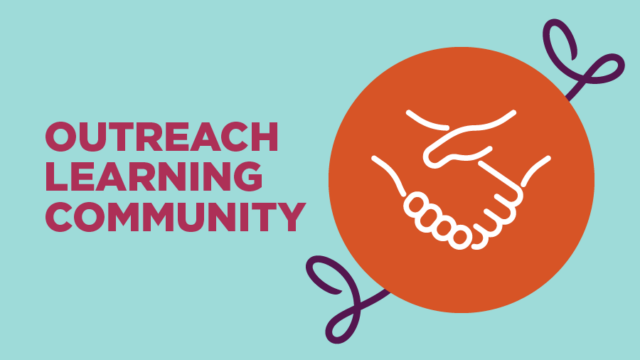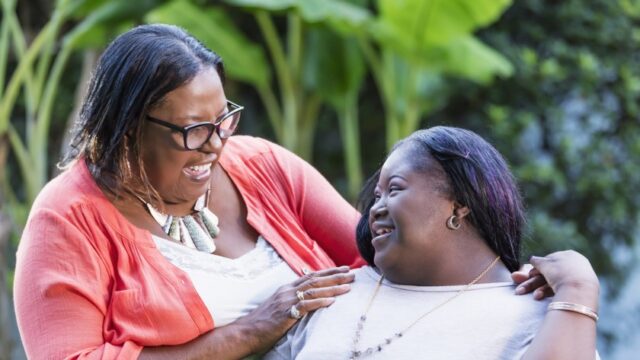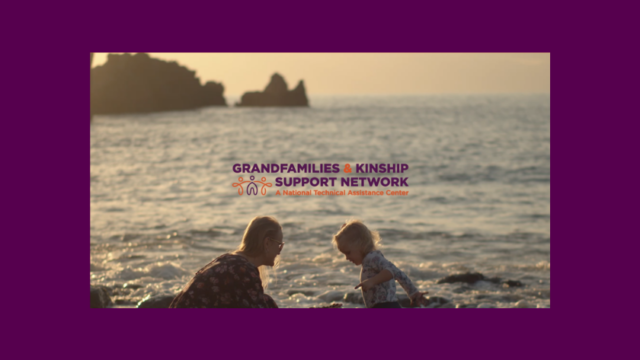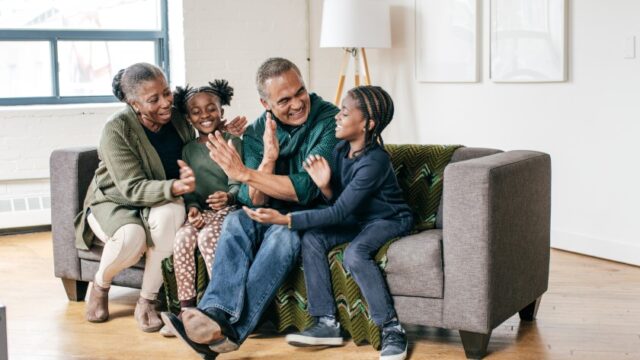
Imagine you are a child. In the middle of the night, your mom drops you off at your grandma’s house to live. Your mom and dad can’t care for you anymore. Their alcohol use has made it impossible to parent. You’re glad to be with your grandma because it feels safe and comfortable at her house, but you’re worried about some things. Where will you go to school? How will you get your asthma medicine? Can your grandma get it for you? Will your mom and dad be okay?
Parental alcohol and other substance use is just one of the many reasons kinship/grandfamilies come together. Kinship/grandfamilies are families in which children reside with and are being raised by grandparents, other relatives, or other adults with whom they have a close family-like relationship (such as godparents or family friends). Other reasons kinship/grandfamilies form include parental incarceration, military deployment, severe disability, deportation, teenage pregnancy, and death. Whatever the cause, when parents are unable to care for their children, kin/grandfamily caregivers often step in at a moment’s notice to keep families together.
Kinship/grandfamilies have unique strengths and face unique challenges. Unlike parents, the caregivers do not have inherent legal rights and responsibilities with respect to the children they raise. They often take responsibility for children suddenly and have no time to plan for financial, housing, or other needs.
What does the research show about the strengths of kinship/grandfamilies?
Decades of research repeatedly confirm that children who cannot remain with their parents thrive when raised by relatives and close family friends.1 Children in foster care with relatives have safer and more stable childhoods than children in foster care with non-relatives, with a greater likelihood of a having a permanent home. They experience fewer school changes, have better behavioral and mental health outcomes, and report that they “always felt loved.” They keep their connections to their siblings, their family and community, and their cultural identity. Moreover, children in foster care with relatives are less likely to re-enter the foster care system after returning to their birth parents. If returning to their parents is not possible, relatives tend to be willing to adopt or become permanent guardians. About 33% of all children adopted from foster care are adopted by relatives, and 11% of children who exit foster care exit into guardianships.2
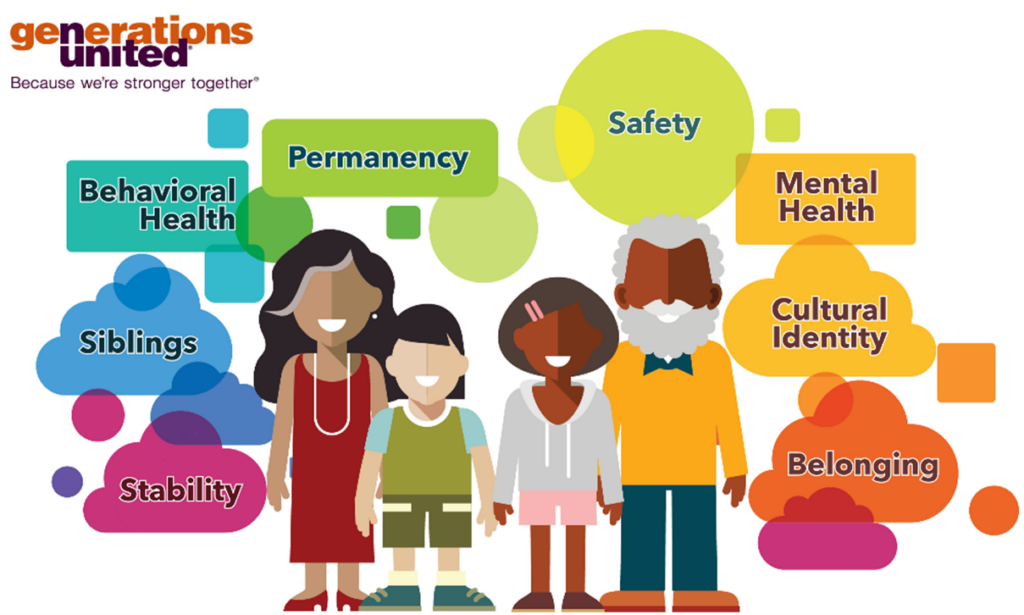
On top of the many benefits to children, caregivers report that they gain from their role, as well, often citing an increased sense of purpose.3 Birth parents may also value that their children remain connected to family and friends.
We have friends who are retired who are always telling me about their next cruise to Hawaii. I tell them I go on cruises every day. I cruise to school, I cruise to the doctor’s office, I cruise to the skateboarding park. Joey is my ‘cruise to Hawaii’ and you know what, I wouldn’t trade my cruise for theirs.
Adrian Charniak, GRAND Voice caregiver advocate, Illinois
How many children live in kinship/grandfamilies?
- About 2.4 million children are being raised by a grandparent, other relative, or close family friend and do not have a parent living in the household.4
- There were 123,294 children in the legal custody of the child welfare system with relatives providing the care in 2022.These children represented over one-third of all children in foster care.5
- The percentage of children in foster care with relatives increased from 26% in 2010 to 34% in 2022.6
- For every one child in the foster care system with a relative providing the care, there are nineteen children being raised by relatives outside that system.7
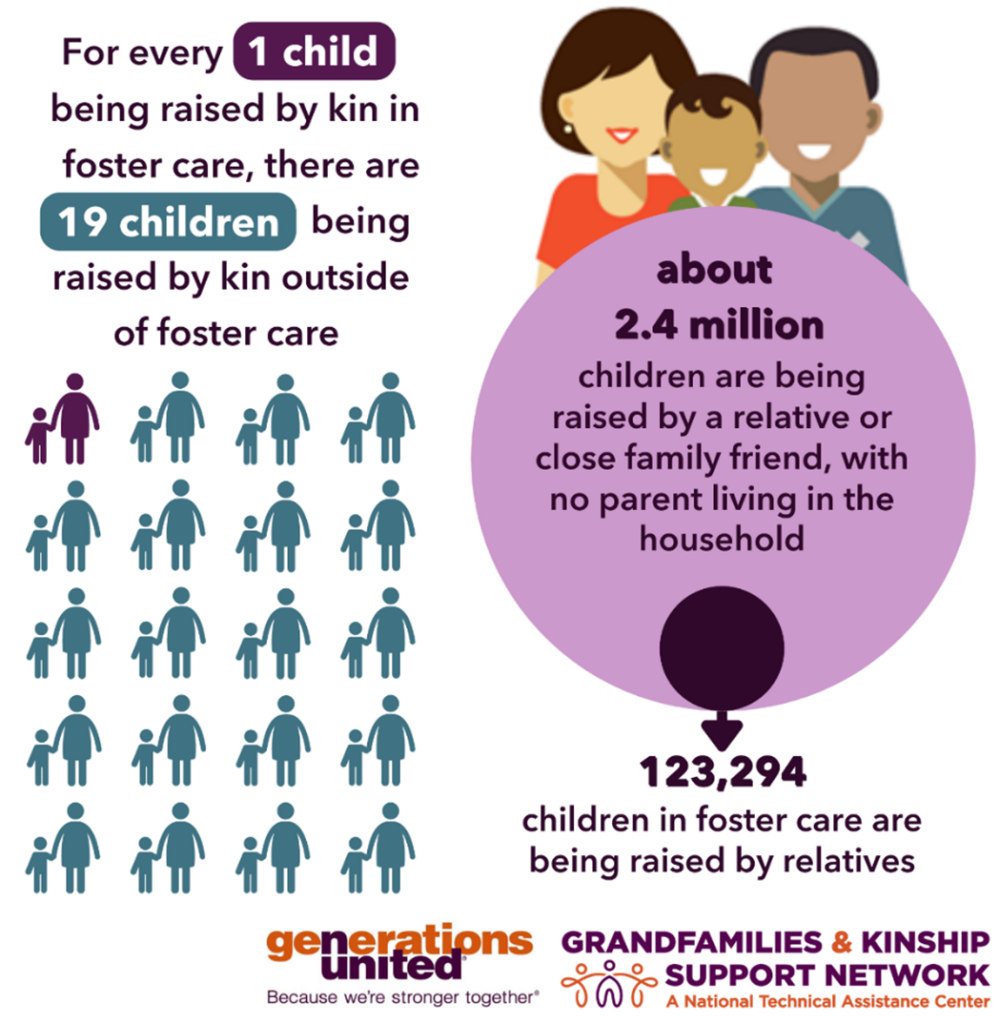
What does available data show about kinship/grandfamilies?
Kinship/grandfamilies include families in which grandparents, other relatives, or close family friends are caregivers, and some data is available on the number of children in these families, as shown above, However, most of the demographic data that is publicly available is about families in which grandparents are raising their grandchildren. The U.S. Census Bureau’s American Community Survey is the primary source for this information, because it includes data on grandparents and grandchildren in families in which grandparents are the head of the household (meaning that they own or rent the home) and self-report that they are responsible for their grandchildren. Below are key data points to learn and consider, as well as links to more information.
Kinship/grandfamilies are racially and ethnically diverse.
- Among children whose grandparents are responsible for them, about 45% are white, 26% are Black or African American, 24% are Latino or Hispanic, 3% are American Indian and Alaska Native, 2% are Asian, 0.4% are Native Hawaiian and other Pacific Islander,17% are two or more races, and 7% are another race.8
- Among grandparents who are responsible for their grandchildren, about 56% are white, 20% are Black or African American, 20% are Latino or Hispanic, 4% are Asian, 2% are American Indian and Alaska Native, 0.4% are Native Hawaiian and other Pacific Islander, 10% are two or more races, and 8% are some other race.9
Technical Assistance Tip: To provide culturally appropriate services for kinship/grandfamilies who are Black or African American, American Indian and Alaska Native, and Latino, consult the racial equity toolkits created for service providers by Generations United.
Members of kinship/grandfamilies are all ages.
- Approximately 34% of children living with grandparents who are responsible for them are under 6 years old, nearly 34% are between the ages of 6 and 11, and 32% are between ages 12 and 17.10
- The percentage of grandparents who are raising their grandchildren and are age 60 and over has increased in the last 10 years. In 2023, approximately 50% of grandparents who were responsible for their grandchildren were age 60 or over, compared to about 36% in 2014.11
Technical Assistance Tip: With our partners at ZERO TO THREE and USAging, the Network can help you design policies and programs to support kinship/grandfamily members of all ages.
Most grandparent caregivers are women.
- About 63% of grandparents living with and responsible for their grandchildren are women.12
Most grandparent caregivers are in the labor force.
- Approximately 55% of grandparents responsible for their grandchildren are in the labor force.13
Technical Assistance Tip: Childcare programs, including before- and after-school activities, are important for many families, especially those with caregivers who are in the labor force. See this brief resource on helping connect families to child care.
Children in kinship/grandfamilies are more likely to be poor than children in other families.
- About 23% of children whose grandparents are responsible for them are living in households with income levels below the federal poverty level, as compared to about 16% of all children.14
- Nearly 18% of grandparents who are responsible for their grandchildren live in poverty.15 Researchers have found that these families are more likely to live below the poverty line in the South than in other regions of the country, but certain states and territories outside the South also have very high rates of poverty among these families.16
Technical Assistance Tip: Kin/grandfamily caregivers often need financial resources and support to meet the needs of children they did not plan or expect to raise. Initiatives like Washington, DC’s Grandparent & Close Relative Caregiver Subsidy Programs, designated by the Network as Exemplary, can be replicated by other jurisdictions.
Grandparent caregivers are more likely than parents to have a disability.
- Approximately 26% of grandparents who are responsible for their grandchildren have a disability, compared to about 7% of parents of children under age 18.17
Technical Assistance Tip: Kinship navigator programs play a critical role in providing information on the range of services that may be available to kinship/grandfamilies; these programs should keep in mind the large number of grandparent caregivers with disabilities when serving the families.
The Network has a list of all known kinship navigator programs around the United States. Six of these programs – in Arizona, Colorado, Florida, Nevada, Ohio, and Washington – are included in the Title IV-E Prevention Services Clearinghouse, and these models are eligible for ongoing federal reimbursement of up to 50 percent of all costs. Other jurisdictions can follow these models with fidelity to access the same federal funds.
Grandparents are raising their grandchildren all across the country and for long periods of time.
- Kinship/grandfamilies exist all across the country. However, researchers have found that grandparents who live with their grandchildren in states in the South and Midwest report that they are responsible for their grandchildren at a higher rate than their peers in other regions.18
- In 2021, about 49% of grandparents who were living with and responsible for their grandchildren reported that they had been responsible for their grandchildren for five or more years.19 “Grandparents were more likely to be responsible for their grandchildren for five years or longer in 2021 compared to 2012.”20
Technical Assistance Tip: It is important for all communities to develop and deliver supportive services for all kinship/grandfamilies. Examples of exemplary programs are available at https://www.GKSNetwork.org/resources/exemplary-policies-practices-and-programs/.
What challenges do kinship/grandfamilies face?
Even with the strengths highlighted above, kinship/grandfamilies encounter many difficulties. Below are key areas in which families face challenges, along with resources to help professionals learn more and discover effective ways to better support the families they partner with and serve.
Legal
Legal issues are frequently among the top concerns for kinship/grandfamilies.
- Unlike parents, kin/grandfamily caregivers do not have automatic legal rights and responsibilities with respect to the children they raise.
- The process of obtaining a legal relationship with the children – such as adoption, legal custody, or guardianship – is usually expensive and time-consuming and can be disruptive to family dynamics.
- Opting to raise the children without any legal relationship may severely limit caregivers’ ability to access services on the children’s behalf.
Technical Assistance Tip: The Network hosted a webinar on the array of legal relationships available to kinship/grandfamilies. Access the webinar recording and associated resources on the webpage for the webinar.
Financial
Having additional children in the household typically requires additional income and/or resources, but available ongoing assistance to help meet these children’s needs is often inadequate and inequitable.
- As noted above, the vast majority of kin/grandfamily caregivers are raising the children in their care without the involvement the foster care system. They are often referred to child-only Temporary Assistance for Needy Families (TANF) grants as the only source of ongoing financial support for the children they are raising. There are many access issues in getting these grants, and they are typically much smaller than foster care maintenance payments. Also, TANF grants only increase incrementally for each child, meaning that a caregiver raising more than one child only gets a slight increase in support for each additional child in their family, rather than receiving an equal amount of support to meet the needs of each child.
- Children in foster care with unrelated caregivers receive monthly foster care maintenance payments. However, because most jurisdictions only make those payments to fully licensed/approved foster parents and most kin/grandfamily caregivers were not foster parents before taking responsibility for the children, most children in foster care with kin/grandfamily caregivers do not receive these payments. A 2023 federal rule and new kin-specific foster care approval standards are beginning to address this inequity.
Technical Assistance Tip: The Network’s legal relationships webinar also featured a discussion about the public benefits and financial supports available to the families. The webpage for the webinar contains the webinar recording and associated resources.
Physical and Mental Health
Both the caregivers and the children in these families face physical and mental health issues to a greater degree than the general population.
- Children being raised by kin/grandfamily caregivers exhibit a variety of physical, behavioral, and emotional problems to a greater degree than the general population of children, often due to the difficult situations that caused them to move into their caregiver’s home.
Growing up with a childhood full of trauma and abuse, there were very few moments where I felt safe and very few people with whom I felt protected. Being put into my uncle’s care was the best decision that could have ever been made for me. It wasn’t an easy road by any means, but I have no doubt in that it completely saved my life.
Kindra, raised by her uncle, California
- Kin/grandfamily caregivers are often socially isolated from their peers and may feel guilt and shame about their adult relative or friend who is unable to parent, especially if it is their own adult child. They may neglect their own physical and/or mental health as they focus on caring for the children.
- Families frequently face obstacles enrolling the children in either public or private health insurance. Some states impose restrictive policies that make it difficult to enroll the children in Medicaid. Private insurance often requires adoption in order for children to be included on caregivers’ policies.
- Kin/grandfamily caregivers may not be permitted to consent to health care for the children in their care, depending on their legal relationship (or lack thereof) with the children and whether their state has a health care consent law.
Technical Assistance Tip: These free-of-charge tip sheets – one on caregiver self-care and the other on youth mental health – can be shared widely, including directly with the caregivers you serve.
Housing
Kin/grandfamily caregivers often begin caring for children without warning or preparation, and they face unique problems with respect to housing.
- Many kin/grandfamily caregivers live in small apartments and houses that are not suitable for children.
- Caregivers living in public senior housing with children may be wrongfully evicted because of the children.
- The presence of children may violate private lease agreements.
- If caregivers do not have legal custody of the children, they are often unable to convince the housing authorities to recognize their need for larger apartments.
Technical Assistance Tip: Over 20 grandfamily-specific housing developments exist around the country. For a list, visit Housing Developments for Grandfamilies.
Education
Many school policies are geared towards “nuclear” families and can pose obstacles for kinship/grandfamilies, especially those families in which there are no legal ties.
- Children may be denied school enrollment if their kin/grandfamily caregivers do not have guardianship or legal custody.
- Grandparents, other relatives, and close family friends acting as parents may have difficulty being included as participants in the Individualized Education Program (IEP) process for children with disabilities.
Technical Assistance Tip: Review Five Actions for Supporting Students and Caregivers in Kinship/ Grandfamilies: A Toolkit for K-12 School Professionals and Kinship Service Providers to learn about how to better support students and caregivers in kinship/grandfamilies. The five actions each include specific steps and embedded tools.
Additional Resources
- www.GKSNetwork.org – A resource library with materials to help the many government systems and community nonprofits working to support kinship/ grandfamilies
- www.gu.org – Resources and publications on kinship/grandfamilies, including Generations United’s annual State of Grandfamilies & Kinship Care Reports
- www.grandfamilies.org – A comprehensive website for publications, materials, and laws impacting kinship/grandfamilies both inside and outside the foster care system
Acknowledgements
For over twenty-five years, Generations United’s National Center on Grandfamilies has been a leading voice for families headed by grandparents, other relatives, and close family friends. Center staff conduct federal advocacy, train grandfamilies to advocate for themselves, and create an annual State of Grandfamilies & Kinship Care Report. Those reports and other resources can be found at www.gu.org and www.grandfamilies.org.
As an aid towards improving public knowledge about kinship/grandfamilies, the Grandfamilies & Kinship Support Network – the first national technical assistance center on kinship/grandfamilies, built and run through a cooperative agreement with the Administration for Community Living – has updated this long-standing resource of Generations United. A previous version was funded by the Brookdale Foundation Group, and we thank them for their support. You are welcome to link to this resource, download it, freely distribute it, and use it.
The Network helps government agencies and nonprofits in states, tribes, and territories work across jurisdictional and systemic boundaries to improve supports and services for families in which grandparents, other relatives, or close family friends are raising children whose parents are unable to do so. For more information, please visit www.GKSNetwork.org.
ENDNOTES
- Generations United, “Fact Sheet: Children Thrive in Grandfamilies,” May 2023, 2, https://www.gu.org/resources/children-thrive-in-grandfamilies/. ↩︎
- U.S. Department of Health and Human Services, Administration for Children and Families, Administration on Children, Youth and Families, Children’s Bureau. “The AFCARS Report: Preliminary FY 2022 Estimates as of May 9, 2023 – No. 30,” May 2023, 4, 6, https://www.acf.hhs.gov/sites/default/files/documents/cb/afcars-report-30.pdf.
Please note that there are limitations with AFCARS data and children in relative foster care may be underrepresented. See www.gksnetwork.org/kinship-data/ for an explanation of the data limitations. ↩︎ - Advisory Council to Support Grandparents Raising Grandchildren, “Supporting Grandparents Raising Grandchildren (SGRG) Act Initial Report to Congress,” U.S. Department of Health and Human Services, Administration for Community Living, November 16, 2021, 19, https://acl.gov/sites/default/files/RAISE_SGRG/SGRG-InitialReportToCongress_2021-11-16.pdf. ↩︎
- Annie E. Casey Foundation Kids Count Data Center, “Children in Kinship Care in United States,” Accessed September 2024, https://datacenter.aecf.org/data/tables/10455-children-in-kinship-care#detailed/1/any/false/2638,2554,2479,2097,1985,1757/any/20160,20161. ↩︎
- U.S. Department of Health and Human Services, Administration for Children and Families, Administration on Children, Youth and Families, Children’s Bureau. “The AFCARS Report: Preliminary FY 2022 Estimates as of May 9, 2023 – No. 30,” May 2023, 2, https://www.acf.hhs.gov/sites/default/files/documents/cb/afcars-report-30.pdf. ↩︎
- Ibid. and U.S. Department of Health and Human Services, Administration for Children and Families, Administration on Children, Youth and Families, Children’s Bureau. “The AFCARS report: Preliminary FY 2010 Estimates as of June 2011 (18),” June 2011, 1, https://www.acf.hhs.gov/sites/default/files/documents/cb/afcarsreport18.pdf. ↩︎
- See www.gksnetwork.org/kinship-data/ for an explanation of this data calculation. ↩︎
- U.S. Census Bureau, “Table S1001 – Grandchildren Characteristics: 2023: American Community Survey 5-Year Estimates Subject Tables,” Accessed December 2024, https://data.census.gov/table/ACSST5Y2023.S1001?q=S1001:%20Grandchildren%20Characteristics. Similar data is not publicly available for other relatives and family friends. ↩︎
- U.S. Census Bureau, “Table S1002 – Grandparents: 2023: American Community Survey 5-Year Estimates Subject Tables,” Accessed December 2024, https://data.census.gov/table/ACSST5Y2023.S1002?q=S1002:%20Grandparents. ↩︎
- U.S. Census Bureau, “Table S1001 – Grandchildren Characteristics: 2023.” Similar data is not publicly available for other relatives and family friends. ↩︎
- U.S. Census Bureau, “Table S1002 – Grandparents: 2023” and U.S. Census Bureau, “Table S1002 – Grandparents: 2014: American Community Survey 5-Year Estimates Subject Tables,” Accessed December 2024, https://data.census.gov/table/ACSST5Y2014.S1002?q=S1002:%20Grandparents. ↩︎
- U.S. Census Bureau, “Table S1002 – Grandparents: 2023.” ↩︎
- Ibid. ↩︎
- U.S. Census Bureau, “Table S1001 – Grandchildren Characteristics: 2023” and U.S. Census Bureau, “Table S0901 – Children Characteristics: 2023.” ↩︎
- U.S. Census Bureau, “Table S1002 – Grandparents: 2023.” ↩︎
- U.S. Census Bureau, Grandparents and Their Coresident Grandchildren: 2021, by Lydia R. Anderson, Clayton Buch, and George M. Hayward, February 2024, 9, https://www.census.gov/content/census/en/library/publications/2024/demo/p20-588.html. ↩︎
- U.S. Census Bureau, “Table S1002 – Grandparents: 2023” and Li, Frank et al., “Prevalence of Parents with Disabilities in the United States,” National Research Center for Parents with Disabilities, The Heller School for Social Policy and Management, Brandeis University, August 2022, Accessed December 2024, https://heller.brandeis.edu/parents-with-disabilities/data-hub/additional-resources/prevalence.html. ↩︎
- U.S. Census Bureau, Grandparents and Their Coresident Grandchildren: 2021, 6, 8. ↩︎
- Ibid., 4. ↩︎
- Ibid., 2. ↩︎
